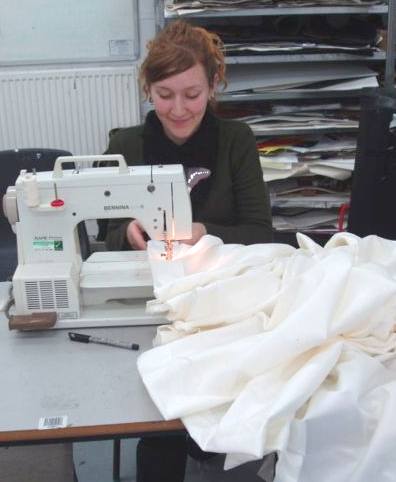|
SEWING
|
|
|
Sewing is an ancient craft involving the stitching of cloth, leather, animal skins, furs, or other materials, using needle and thread. Its use is nearly universal among human populations and dates back to Paleolithic times (30,000 BC). Sewing predates the weaving of cloth and is an essential element in the joining of modern tents, marquees, awnings, etc., using heavy duty machines to sew the canvas, and sometimes pvc linings, roofs and decorations.
Seamstress using a modern electric Bernina sewing machine
Sewing is used primarily to produce clothing and household furnishings as curtains, bedclothes, upholstery, and table linens. It is also used for sails, bellows, skin boats, banners and other items shaped out of flexible materials such as canvas and leather.
Most sewing in the industrial world is done by machines. Pieces of a garment are often first tacked together. The machine has a complex set of gears and arms which pierces thread through the layers of the cloth and semi-securely interlocks the thread.
Some people sew clothes for themselves and their families. More often home sewers sew to repair clothes, such as mending a torn seam or replacing a loose button. A person who sews for a living is known as a seamstress (or seamster), dressmaker, tailor, or garment worker.
"Plain" sewing is done for functional reasons: making or mending clothing or household linens. "Fancy" sewing is primarily decorative, including techniques such as shirring, smocking, embroidery, or quilting.
Sewing is the foundation for many needle arts and crafts, such as applique, canvas work, and patchwork.
General sewing methods
Almost all of these methods can be done by either hand, sewing machine, or a serger; however, the specific techniques used can be quite different. Some methods are not appropriate for some applications, even though it may be possible to replicate another method. As an extreme, you could technically duplicate serging with hand sewing, but it would take at least several hundred times as long to do the same work. Furthermore, some techniques are not possible with other methods: making an embroidery stitch called a French knot is easy by hand, but impossible by sewing machine or serger.
Seam allowance
Seam allowance is the area between the edge and the stitching line on two (or more) pieces of material being stitched together. Seam allowances can range from 1/4 inch wide (6.35 mm) to as much as several inches. Commercial patterns for home sewers have seam allowances ranging from 1/4 inch to 5/8 inch.
Sewing industry seam allowances range from 1/4 inch for curved areas (e.g. neck line, armscye) or hidden seams (e.g. facing seams), to one inch or more for areas that require extra fabric for final fitting to the wearer (e.g. center back).
Occupations requiring sewing
Sewing tools and accessories
|
|
|
This website is Copyright © 2013 Kismet Girls Trust. All rights reserved. All other trademarks are hereby acknowledged. |
